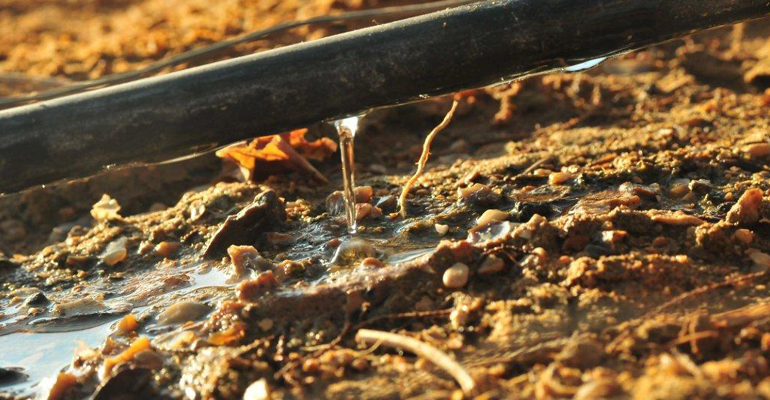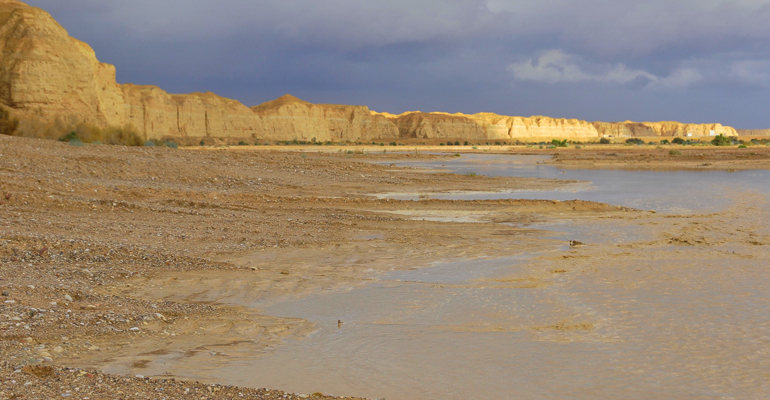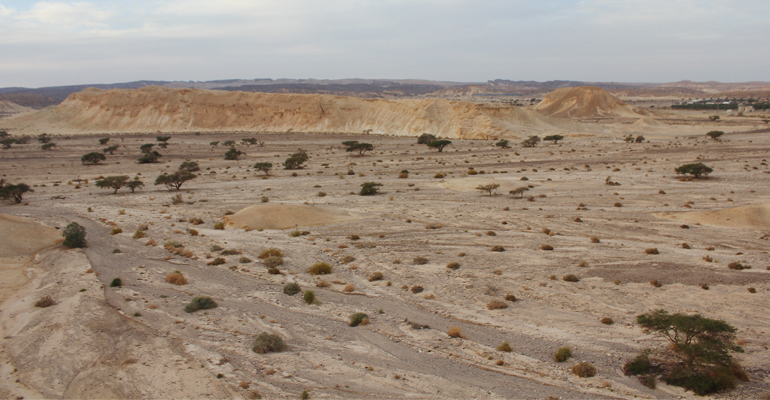Soil and Water
Soil and water resources in the central Arava region are limited and saline. Efficient water and nutrient use is indispensable to secure sustainability of rural agriculture in the region. Therefore, the department investigates efficient fertigation managements, which will increase the yield and quality of the crops on one hand, and on the other, reduce water and agrochemical inputs. The predicted reduction in the irrigation water salinity necessitates us to investigate for optimal water quality and quantities that will yield the highest profits.
The department is focused on 2 main research programs:
- Increased water use efficiency - In these studies, we develop optimal fertigation managements, which can be suitable under conditions of limited water resources and brackish water. Investigation of partial nighttime irrigation for efficient salt leaching; subsurface drip irrigation in melons; an optimization of drip spacing and discharge for various crops, etc.
- Crop response to environmental stresses - studies of water drought and salt stress, under hyper-arid region in several vegetable and fruit crops. These studies will allow us an integrative understanding for application of an optimal irrigation water quality and quantity that guarantees highest profits.
Recent Reports
-
12yearsago
Effect of irrigation treatments, soil type and root-zone infrastructure on pepper plants, 2010/11
Vegetables, Soil and WaterEffect of irrigation treatments, soil type and root-zone infrastructure on pepper plants, 2010/11
תחום או ענף ירקות
תאריך עדכון 23/2/2012Effect of irrigation treatments, soil type and root-zone infrastructure on pepper plants, 2010/11
Ityel Eviatar – Extension Service (Shaham), Ministry of Agriculture and Rural Development
D. Chashmonai, A. Oshoroviz, R. Offenbach, S. Cohen, Y. Zvieli, I. Tsabari – Central and Northern Arava R&D
Alon Ben-Gal – Gilat Research Center, Agricultural Research Organization, Ministry of Agriculture and Rural Development
Naftali Lazarovitch – Ben-Gurion University
E-mail address for correspondence: Eviatar@arava.co.ilThis work is a continuation of work carried out during previous seasons concerning the development of root-zone infrastructure for vegetable crops in the Arava. The reaction of pepper plants to the conditions prevailing in the root zone was studied within a range of different volumes of saline irrigation water (2.3 dSm-1) in two soils with extremely different hydraulic characteristics: rocky soil ('Hamada') with a low level of water conductivity and sandy soil, through which water flows easily. Pepper plants of the cultivar Adom (Efal) were transplanted into a screen-house (50 mesh) at the Yair Research Station in the Arava on 20 September 2010. These plants were treated with four different levels of irrigation from 21 days after transplanting through the end of the study. The levels of irrigation: 3.1, 4.4, 5.5 and 7.5 mm per day; were kept constant throughout the period of the study. At the end of the season, 194 days after transplanting, the total volumes of irrigation water that had been applied were 634, 771, 1071 and 1399 mm . In the two soils, we set up two types of root-zone infrastructure, which differed only in the type of side-sheeting used to separate the root zones from the surrounding soil. One treatment involved Palrig soil cover, which is permeable to water and oxygen, and the other treatment involved impermeable polyethylene. The treatment in which the polyethylene side-sheeting was used yielded 10% less than the Palrig treatment. Yield in the rocky soil was approx. 15% higher than yield in the sandy soil across all of the irrigation treatments. The level of irrigation had significant effects in the two soils. In the sandy plots that were irrigated with 4.4-5.5 mm/day, fruit yield increased by approx. 20%. In the rocky plots that were irrigated with 5.5-7.3 mm/day, yield increased by approx. 15%.
Acknowledgements
We would like to thank the Plant Board for helping to fund this study and Zeraim Gedera for their donation of seed. We also extend our heartfelt thanks to all those who participated in this work.שפה English
מלות מפתח Ben Gal
מחבר Ityel Eviatar, D. Chashmonai, A. Oshoroviz, R. Offenbach, S. Cohen, Y. Zvieli, I. Tsabari, Alon Ben-Gal, Naftali Lazarovitch
שנה 2011
שייכות yzvieli
תאריך יצירה 23/2/2012
תאריך עדכון 23/2/2012 -
12yearsago
Application of organic matter in trenches for pepper production
Soil and Water, Vegetables21
תחום או ענף ירקות
תאריך עדכון 23/2/2012Application of organic matter in trenches for pepper production
Shlomo Kramer – Field Service, Extension Service, Negev Region, Ministry of Agriculture and Rural Development
Shabtai Cohen, Rivka Offenbach, Yoram Zvieli – Central and Northern Arava R&D
Israel Zer – Moshav Paran
E-mail address for correspondence: shlomo@arava.co.ilDifferences in soil composition along the length of plots lead to non-uniform development of plants, which leads to variation in yield. In order to cope with this problem and obtain uniform crop growth throughout the plot, a trench is dug in the center of the plot. The trench is filled with homogenous material such as tuff, Perlite or stabilized organic matter. There are a number of different variations on this technique. Organic matter is the cheapest material, is easy to apply and also makes a significant contribution of a range of nutrients for the plants.
Two application methods were evaluated in pepper during the 2010/11 growing season at the Zer farm at Moshav Paran. This study evaluated trenches filled with organic matter (14 m3 per dunam) over which two lines of drippers were set out and very shallow “trenches” in which the same amount of organic matter was applied.
At the beginning of the season, the plants in the beds with the deeper organic matter-filled trenches were in poor shape relative to the plants in the beds in the shallow-trench treatment, apparently due to the salinity of the organic material. After two harvests, an absolute difference between the two treatments was observed in two different cultivars. In the shallow-trench treatments, cv. Tirza yielded 2 tons/dunam (=kg/m2) and cv. Imperio yielded 1.75 tons/dunam. In contrast, in the treatment with the deeper trenches, cv. Tirza yielded 0.85 tons/dunam and cv. Imperio yielded 0.23 tons/dunam. This difference persisted throughout the growing season. For cv. Imperio, the highest yields were 12 tons/dunam in the shallow-trench treatment and 10.4 tons/dunam in the organic-matter treatment. The cv. Tirza yielded 13.3-11.2 tons/dunam.
Soil analyses, which were carried out every three weeks, revealed a higher level of salinity in the 0–15 soil layer than in the 15–30 soil layer in both trench treatments. Levels of phosphorous and potassium were high throughout the season. In the organic matter-filled trench treatment, the level of nitrogen remained high at the end of the season. The electrical conductivity of the soil solution, which was assessed using partially automatic pumps, increased from early September through the end of October at depths of 15 and 30 cm and reached 4-5 dSm/meter. This is also the period during which the amount of water needed by the crop peaks and, apparently, the level of irrigation was not sufficient to fully rinse the accumulating salts from the root zone.
This experiment demonstrates the importance of using properly processed and stabilized organic matter to fill trenches that were not loosen-cultivated. The mixing of the organic matter in the trench with the soil, by shallow tillage, ensures proper, rapid crop development even when the organic matter has not been stabilized as well as it could have been or in situations in which time limitations force growers to plant shortly after organic matter has been applied to the trenches.שפה English
מחבר Shlomo Kramer, Shabtai Cohen, Rivka Offenbach, Israel Zer
שנה 2011
שייכות yzvieli
תאריך יצירה 23/2/2012
תאריך עדכון 23/2/2012 -
13yearsago
Optimizing irrigation frequency and volume for peppers irrigated with saline water
Soil and Water, Vegetablesתחום או ענף אגרוטכנולוגיה; ירקות
תאריך עדכון 29/9/2011
תיאור מלא Optimizing irrigation frequency and volume for peppers irrigated with saline water
S. Kramer, E. Kenig – Extension Service (SHA'AM), Ministry of Agriculture
A. Ben-Gal - Gilat Research Center, Agricultural Research Organization, Ministry of Agriculture
R. Offenbach, A. Maduel, M. Kapun - Central and Northern Arava R&DEmail for correspondence: shlomo@arava.co.il
The increase in the amount of area cultivated by each farmer together with the addition of new families to the Arava region have negatively affected the water restriction for all growers. Together with the increase in water consumption in recent years, the quality of irrigation water has deteriorated as a result of the increased salinity of the local well water. The practice of growers using excessive irrigation to ensure that the crop will never lack for water and that excess salts are washed out of the root zone has worsened the state of the depleted water reserves. The results of experiments to evaluate the feasibility of irrigating based on tensiometer readings have taught us that irrigation in the field can be timed so that the plants receive the amount of water they need, corresponding to the effects of changes in the weather. The average amount of water applied daily decreased in all treatments as the days became shorter and temperatures fell. The frequency of irrigation changed according to increases in the quantity of water applied at the time that tensiometer reading was observed in the field. According to the obtained results, the efficiency of irrigation was improved in all treatments without any damage to yield levels.
In an experiment conducted in pepper in a greenhouse at the Zohar Experimental Station in Sodom Valley during the 2009/10 growing season, we evaluated three irrigation programs that were carried out based on continuous tensiometer readings, which were used to determine ahead of time the amount of water to be applied when the tensiometer reading was received. The actual frequency of irrigation was the result of a combination of a threshold value for activating the irrigation system and the quantity of water to be supplied when the tensiometer reading was received. The choice of a value for which the water potential was relatively low (absolute value) in combination with a water quantity of 4 mm led to once-a-day irrigation. The use of a similar threshold value with a water quantity of 1 mm led to irrigation at a frequency of 3-5 times per day. The use of a threshold value for which the water potential was very low and a water quantity of 0.2 mm led to a irrigation at a frequency of 25 times per day. In two additional treatments, we started and stopped irrigation based on threshold values that had been determined ahead of time. The amount of water applied was a function of these values. In a treatment in which the starting and stopping of irrigation was controlled by a shallow tensiometer, plants were watered twice a day during warm periods and once a day during the winter. Turning on the irrigation based on the readings of a shallow tensiometer and turning it off based on the readings of a deep tensiometer led to once-a-day irrigation for most of the growing season. In all of the treatments, the amount of water applied each day decreased as the days became shorter and the air became cooler. From the end of the winter, the quantity and frequency of irrigation increased as the days became warmer and longer.
We examined two characteristics of pepper development: A) the lateral growth of the plants, which was monitored from three weeks after the plants were transplanted through January 5, 2010; and B) the numbers of internodes and fruit. No differences in these characteristics were observed between the treatments. We also monitored changes in the salinity of the soil solution at four depths and two locations relative to the dripper: next to the dripper and 10 cm away from it along the length of the branch. In the treatment in which 0.2 mm of water were applied when the tensiometer reading was received, the electrical conductivity of the soil solution increased beginning in mid-November, when the amount of daily irrigation began to be gradually decreased. In the treatment in which1 mm of water was applied, the electrical conductivity of the soil remained stable throughout the growing season. This treatment also had the highest yield, 6.57 tons/dunam. In the treatment in which an irrigation quantity of 4 mm was applied, there was an increase in the electrical conductivity of the soil solution from the beginning of January, parallel to the move to irrigating once every two days and a decrease in the daily irrigation level to 2 mm. This treatment had the lowest yield, 5.74 tons/dunam. The high level of salinity in the root zone during the winter explains why the fruits in this treatment were particularly small. In the treatment in which the irrigation was turned on according to the readings of a shallow tensiometer and turned off based on the readings of a deep tensiometer, large irrigation amounts of 4-5 mm per day were applied throughout most of the period. In late January and early February, the daily irrigation amount was decreased to 3 mm and there was a parallel, moderate increase in the salinity of the soil solution. In the treatment in which irrigation was turned on and off based on the readings of a shallow tensiometer, the amount of water applied daily decreased to 1.8 mm that were applied each time the system was turned on, from mid-January through the beginning of March. During this period, there was an initial moderate increase in the electrical conductivity of the soil solution and, over time, there was an increase in the rate at which the electrical conductivity values were increasing. As the weather became warmer and we began to irrigate twice a day (for a total amount of 4 mm or more), the electrical conductivity decreased sharply.
These results demonstrate the need to apply irrigation volumes that exceed consumption, even during the winter, in order to maintain a relatively low and stable level of salinity in the root zone. These processes occur in all crops irrigated with saline water.Acknowledgements
We would like to thank the Scientist’s Fund of the Ministry of Agriculture and Rural Development for funding Research Program no. 08-1498-870.שפה English
מלות מפתח greenhouse vegetable production, pepper, water conservation
מחבר Shlomo Kramer, Elisha Kenig, Alon Ben Gal, Rivka Offenbach, Ami Maduel, Moran Kapun
שנה 2010
שייכות yzvieli
תאריך יצירה 29/9/2011
תאריך עדכון 14/3/2012





